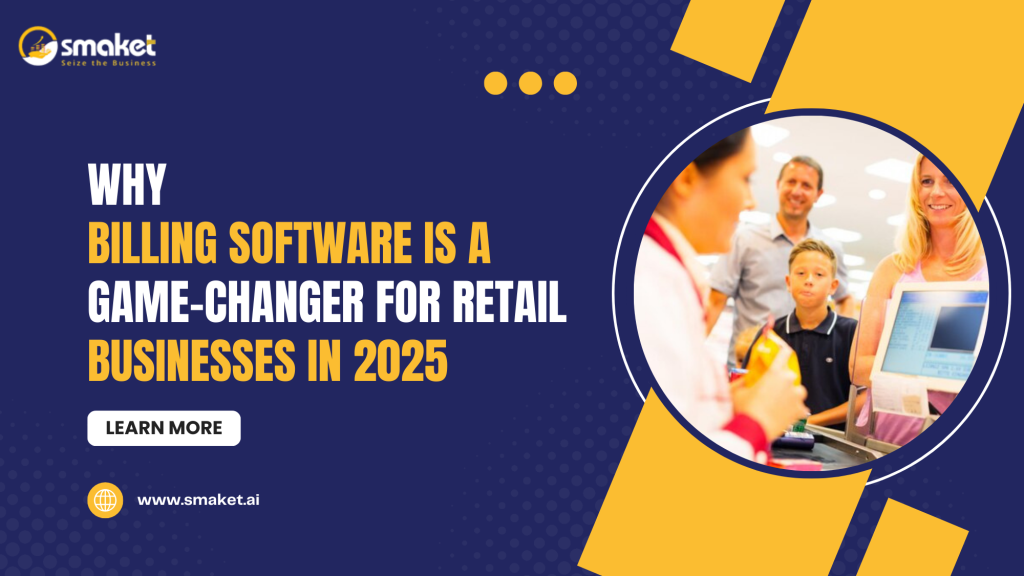Why Billing Software is a Game-Changer for Retail Businesses in 2025
In today’s fast-paced retail environment, businesses must evolve quickly to meet increasing customer expectations and operational demands. In 2025, one of the most vital tools for retail success is Billing Software. No longer just a system for printing receipts, modern billing software integrates with inventory, payments, and analytics to offer a comprehensive business solution.
Whether you’re running a supermarket, a clothing boutique, or an electronics store, having robust billing software can be a true game-changer. This blog dives deep into how billing software is revolutionizing the retail sector, what features to look for, and why it’s a smart investment for any retail business in 2025.
What is Billing Software in Retail?
Retail billing software is a digital solution designed to automate the process of generating invoices, calculating totals, applying taxes (GST/VAT), managing stock levels, and facilitating various payment methods. It often integrates with other essential tools such as inventory management systems, accounting software, and customer relationship management (CRM) platforms, ensuring a streamlined retail operation from end to end.
Modern billing software is cloud-based, meaning it can be accessed from anywhere, offering real-time insights and control for business owners.
Key Features of Retail Billing Software in 2025
Today’s billing solutions are packed with features that go far beyond just printing receipts. Here’s a breakdown of the core capabilities:
1. Automated Invoicing
With barcode scanning and product lookup functionality, invoices can be generated within seconds, reducing errors and speeding up transactions.
2. Inventory Integration
Real-time inventory updates ensure your stock levels are accurate after every sale. This eliminates manual data entry and helps prevent stockouts or overstocking.
3. Multi-Payment Options
Support for cash, credit/debit cards, UPI, mobile wallets, and even BNPL (Buy Now, Pay Later) services ensures a seamless checkout experience for all customers.
4. GST & Tax Compliance
Automatic tax calculations based on regional laws (like GST in India or VAT in the EU) keep your business compliant and simplify reporting for tax returns.
5. Customer Management
Store customer purchase history, issue loyalty rewards, and send personalized offers. This builds customer retention and drives repeat business.
6. Reports & Analytics
Detailed sales reports, product-wise performance tracking, and profit margin analysis help you make informed business decisions in real time.
7. Cloud Access & Mobile Compatibility
Many solutions offer mobile apps or cloud dashboards, so you can manage your store operations remotely—ideal for owners with multiple outlets.
Benefits of Billing Software for Retail Businesses
Investing in billing software isn’t just about convenience—it directly impacts profitability and efficiency. Here are some of the standout benefits:
1. Faster Checkout Process
Speed up billing and reduce queues during peak hours. A smooth checkout enhances the customer experience and boosts sales.
2. Accurate Data Entry
Automated processes reduce the likelihood of human error in invoicing, inventory management, and pricing.
3. Cost-Efficient Operations
Billing software cuts down on manual work, reducing labor costs and improving staff productivity.
4. Real-Time Sales Tracking
Track sales performance by day, week, or month. Real-time analytics help identify trends and improve business strategy.
5. Scalability
Easily handle the growth of your business with support for multi-store management, cloud data synchronization, and user-level access control.
6. Enhanced Customer Engagement
Leverage stored customer data to run loyalty programs, send personalized discounts, and collect feedback for improved service.
How to Choose the Right Billing Software for Your Retail Store
Choosing the right billing software is critical for maximizing your ROI and ensuring a smooth transition. Here’s a checklist to help guide your decision:
1. Ease of Use
Choose software with a clean, user-friendly interface. Your staff should be able to learn and use it with minimal training.
2. Scalability
Ensure the software can grow with your business, supporting new branches, increased transaction volume, and advanced features as needed.
3. Integration Capabilities
Look for a solution that integrates seamlessly with your existing accounting software, eCommerce platforms, and CRM tools.
4. Customer Support
Round-the-clock customer support is crucial, especially during sales peaks. Opt for a provider known for responsive service and frequent updates.
5. Cost vs. Value
Don’t just consider the initial cost—assess the long-term benefits, automation features, and potential time/labor savings for a better ROI perspective.
Trends Shaping Retail Billing Software in 2025
The retail billing software landscape is evolving rapidly with technology. Here are some of the latest trends driving change in 2025:
- AI and Predictive Analytics: Suggesting restocks, predicting customer behavior, and optimizing sales strategies.
- Omnichannel Integration: Unified billing across physical stores, mobile apps, and eCommerce websites.
- Voice-Enabled POS: Voice commands to process billing and check inventory hands-free.
- Blockchain for Invoicing: Enhancing transparency, security, and data integrity in transactions.
Conclusion:
In 2025, Billing Software is more than a transactional tool—it’s the backbone of efficient, customer-centric, and profitable retail businesses. From improving the checkout process to managing inventory and providing actionable insights, billing software equips retail owners with everything they need to stay ahead in a competitive market.
Investing in the right billing software today means embracing a future of streamlined operations, satisfied customers, and sustainable growth.

